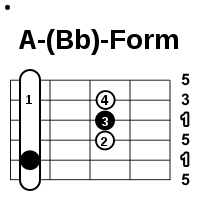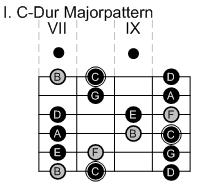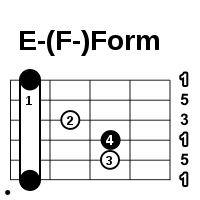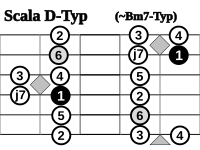Guitar/Major Patterns
| Minimum requirements | |
|---|---|
| Open Chords The Major Pentatonic The Minor Pentatonic | |
| Related chapters | |
| Major scale shapes as individual lessons | |
| Further chapters | |
| 3-Notes-Per-String Scales | |
This page is currently being translated from German into English. • Expect some errors and inconsistencies. • Give the author some time to correct the deficiencies. • Assisted the translator because he is not a native speaker. • The Wikitorians among you may help me with the peculiarities of English Wikibooks. (how you handle things). • Be patient. The translation of the finished German lesson (links in the navigation) will take time. |
The Major Patterns
[edit | edit source]- Preface and overview of the upcoming lessons
In the following lessons we want to deal with the major scale and scales derived from the major scale (especially the natural minor).
We assume certain basic knowledge in playing guitar.
The major and minor scales cover a wide range of music. However, I want to say right away that this doesn't cover everything. Especially in blues and blues-influenced rock improvisations, other scales are required. And if you're hoping to improvise like this in the near future because someone on some video portal told you to do that, then I'll have to temper your expectations a bit. This is primarily about pop and rock songs that are set in a major or minor scale. Other scales and genres will be the subject of another lesson.
But you have to start improvising somewhere, and the following so-called CAGED scales are a good way to get started.
Foundation
[edit | edit source]We'll start with the C major scale, which you can hopefully already understand in the first three frets.
It is a good exercise to write down the arrangement of the tones of the entire fretboard on a calculator sheet, while observing the correct spacing (half and whole tone steps).
So that we can transpose the scale as desired, we will only consider the intervals of the major scales.
- C major scale
- C = 1, D = 2, E = 3, F = 4, G = 5, A = 6, B = j7
These intervals can be transferred to any other key.
- D major scale
- D = 1, E = 2, F# = 3, G = 4, A = 5, B = 6, C# = j7
The following scale contains all the notes of a major scale. The scales can be transposed like a barre chord. Think of it as if you were working with a capo.
The number "1" indicates the position of the root note of a major scale. (German) the position of the barre chords, will help you find the root notes. You discover the root of the major scale by looking for the semitone steps.
So all you have to do is move the scale back and forth on your fingerboard until the "1" is on the root note of your desired major scale, then you can use the scale.
However, the entire scale across the entire fingerboard is a bit too much, so we'd better divide it into smaller, useful sections.
Attention: Don't learn everything at once!
[edit | edit source]Trying to learn everything at once is quite tiring. You don't learn to improvise in a weekend. So plan enough time for learning and practicing. And don't expect your first attempts at improvisation to sound particularly good. They don't have to do that at all. It should only fit halfway, because you're not supposed to be able to improvise, you're supposed to learn it.
However, all musical scales can be broken down into many small elements, which can then be found and learned very easily.
| first fingering | second fingering | third fingering |
|---|---|---|
 |
 |

|
You can then assemble the scales from the small elements like in a Lego game. And with that you can conquer one scale after the other.
We will first start by learning the 5 so-called CAGED scales.
| Intervals | C major scale | Basic chord shape |
|---|---|---|
 |
 |

|
 |
 |

|
 |
 |

|
 |
 |

|
 |
 |

|
Don't get carried away
[edit | edit source]Don't be blinded by unrealistic promises on video portals and don't listen to anything that's only intended for advanced players. The first exercises are plain and simple. It's just a matter of getting your hands on the fingerings. The first improvisations on songs are also carried out at a moderate tempo (i.e. slowly). It must initially not be rhythmically demanding and sophisticated. And there is no intention of an independent solo yet. This is what you work on when you have the scales in your fingers safely and without thinking. If an exercise example is too demanding, postpone it until a later repetition and in the meantime practice the somewhat simpler exercises on all string positions.
Slide module
[edit | edit source]Although the 5 CAGED scales are fundamental to improvising on the fretboard, they do not cover everything that one may encounter when improvising on major and minor scales.
We will learn how you can easily slide from one scale form into the neighboring scale form. Maybe the barre chords or power chords are easier to grasp there, or you can get a run or a lick or an ornament (e.g. hammering) easier.
For this we will use the slide module.
or between the G and B strings:
This will allow you to improvise across the entire fretboard and at the same time learn that no one is forcing you to stay locked in a scale, as the English word CAGED suggests. View a particular pattern more like an orientation in city maps, where the transition to neighboring towns and suburbs is smooth.
Excursus: Minor scales can be derived from the major scales
[edit | edit source]Before you try to memorize the correct intervals of the minor scales, let's make learning a little easier by initially viewing each minor scale as a parallel to the major scale.
The only thing you have to keep in mind is that the root of the minor chords here does not start with the "1", as is usually the case, but with the "6", since the root of a minor chord corresponds to the sixth note of the parallel chord Major scale corresponds.
Actually, the intervals of a minor scale are not counted like this:
- 6 - j7 - 1 - 2 - 3 - 4 - 5 - 6
but the intervals should correctly be counted like this.
- 1 - 2 - 3b - 4 - 5 - 6b - 7 - 1
The intervals for the minor scale would then be set correctly, but it wouldn't be of much use for your initial orientation. It confuses more than it helps at this point. This doesn't make the scales any clearer. Therefore, it is much easier if the major scales fit the parallel minor keys at the same time.
In this case we are usually talking about a pattern, i.e. a pattern that fits several scales (major or minor and also church keys). By scale we usually mean a specific scale, by pattern the pure fingering that has not yet been determined in major or minor or another mode. But don't be surprised if we accidentally use the terms interchangeably.
So we proceed like reading music. The music reader first uses the accidentals to determine the underlying major key and only in the second step does he check based on the chords or the tone sequence whether there is a minor key or another mode.
You can catch up later on what the intervals look like in detail if you are more interested in jazz chords and jazz harmony.
Speaking of jazz chords; We assume that you initially prefer the barre chords of the E and A forms for finding the root tones and will therefore focus more on these. Later, the other chord shapes that you get to know in fingerstyle and jazz will also serve as your orientation.
Expand CAGED
[edit | edit source]The 5 CAGED scales do not always provide a convenient transition between barre chords, arpeggios and improvisation. They also contain some difficult chord shapes. And if you seeIf you want to play quickly, the place where there are only two notes on one string disrupts the flow of the game. A few hammerings or slides don't work at all because the corresponding notes are on different strings. You will learn that every fingering on every string (and consequently also on all CAGED scales) can be extended anywhere by two frets to the right or to the left. This of course changes the fingering and causes individual fingers to overextend, but some licks and riffs work better this way. We will derive other scale concepts from the CAGED scales in this way. This way you keep the orientation you acquired with CAGED, because you always know where the square or where the next semitone steps are.
3NPS
[edit | edit source]We use the above-mentioned extension for the (German) 3-Notes-Per-String Scales (3NPS for short), which opens up further possibilities for us. (Especially the (German) Sweeping).
As you can see, you have to stretch your fingers too much and you have to change position several times with the 3NPS scales. In addition, you can no longer easily extend this fingering by two frets to the right or left, as was possible with the 5 CAGED scales. But we still have the 1st and 2nd fingering of the CAGED scales that we learned before, so not everything will be completely new for you.
(German) Modal Scales with 3NSP explained
[edit | edit source]You can easily switch from a barré chord to improvisation via the 3NPS, no matter what function the chord currently has (tonic, subdominant, dominant or their parallels). In this way you are gradually introduced to modal improvisation (church scale for the AST = chord scale theory).
Berklee Scales
[edit | edit source]If you later want to play more demanding polyphonic arrangements (especially jazz, classical and fingerstyle), you can expand the CAGED and 3NPS scales to the so-called (German) Berklee scales by William Levitt. It avoids changing position, but does not require hyperextension. And it is not structured as systematically as the previous ones. It uses all the notes in one position, and you can sometimes use more handy chord shapes than with the previous scales. If you discover the proximity to the CAGED and 3NpS scales, not everything will be completely new to you, and you will easily keep your bearings even with the Berklee scales.
With the ability to expand a CAGED scale by two frets to the right or left at any time, you can work on both the 3NPS scales and then the Berklee scales.
Each of the (German) 3 scale concepts has its particular strengths.
- Simplified
- Use CAGED for orientation and quick learning.
- Use 3NPS for fast scale runs.
- Use Berkelee for polyphonic arrangements.
- Start with
- Major scale shapes as individual lessons
Template:Navigation backupforward












